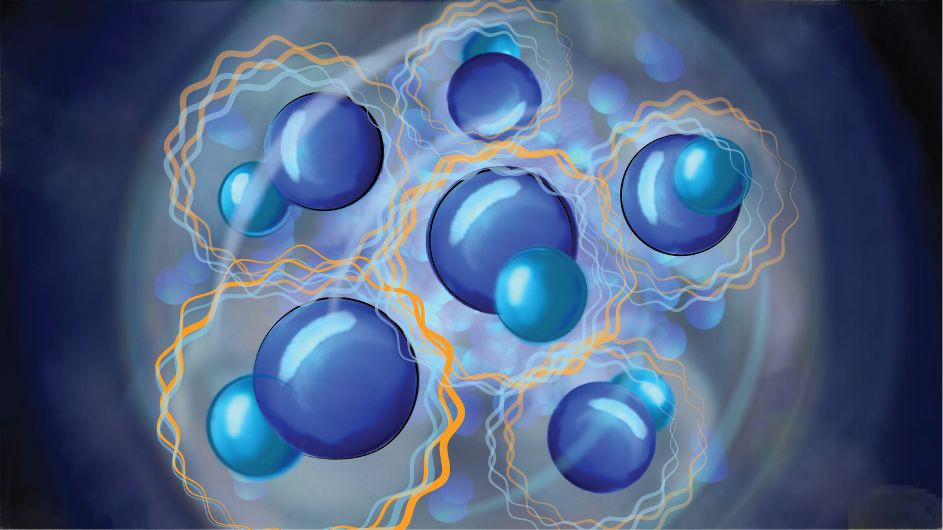A Microwave Shield Yields Ultracold Dipolar Molecules
A new technique takes a bosonic gas to its lowest temperature yet and a step closer to a molecular Bose-Einstein condensate.

Almost a century ago, physicists Satyendra Nath Bose and Albert Einstein predicted a theoretical state of matter in which individual particles would, at extremely cold temperatures and low densities, condense into an indistinguishable whole. These so-called Bose-Einstein condensates (BECs) would offer a macroscopic view into the microscopic world of quantum mechanics. In 1995, theoretical BECs became an experimental reality, which garnered the physicists who created them a Nobel Prize. Labs around the world—and even in space—have been creating them ever since.
All of the BECs created so far to ask fundamental questions about quantum mechanics have been made from atoms. It has proven much harder to make molecules cold enough to approach a BEC state, which hover fractions of a degree above absolute zero, and to keep the molecules stable long enough to conduct experiments.
“For twenty years, there have been proposals about what you could do with stable ultracold molecules, but it has been tough on the experimental side because the lifetime of molecular samples has been short,” said Columbia physicist Sebastian Will, whose lab specializes in creating ultracold atoms and molecules.
The science of creating ultracold molecular gases has been heating up with the help of microwaves. Last year, researchers in Munich used microwaves to help cool a sample of fermionic molecules. Fermions are one of the fundamental types of particles in the universe. Will and his lab have now realized a complementary step to the Munich researchers’ work with the other: bosons. Writing in Nature Physics, Will’s team uses microwaves emitted from a custom-built antenna to extend the lifespan of a bosonic gas of sodium-cesium molecules from a few milliseconds to over one second, a critical first step to cooling them. With their longer-lasting sample, they dropped the temperature to 36 nanoKelvin—just shy of the temperature needed for the molecules to form a BEC.
“It’s a big question mark what will happen as we go colder. We’re looking at completely new physics given the complexity of these molecules.”
The technique the Will lab used was proposed by Tijs Karman, a theoretical physicist at Radboud University in the Netherlands who collaborated on the paper. Microwaves are a form of electromagnetic radiation that make molecules rotate. If the molecules in question are water molecules in something that you’ve placed in a microwave oven in your kitchen, that motion creates friction that ultimately heats up your food. If they are sodium-cesium in a physics lab, the microwaves create a shield that prevents the molecules from sticking to each other and getting lost from the sample. Once held in place, the molecules can successfully be subjected to evaporative cooling. That’s a similar process to blowing on a hot cup of coffee: after removing the top layer of “hot” molecules, the remaining molecules rethermalize to a cooler temperature.
Will’s lab has been constructing their experimental apparatus to create ultracold gases of sodium-cesium over the past five years. Their results on assembling ultracold sodium-cesium molecules from ultracold gases of sodium and cesium atoms were published earlier this year in Physical Review Letters in a paper led by postdoc Ian Stevenson. “Assembling ultracold molecules is a huge technical challenge but it is something that had been shown before for other molecules,” he said. “Our real goal is to do something new, and microwave shielding in the hopes of creating a molecular BEC is fundamentally new.”
While there is still work to do to reach BEC temperatures, the lab’s ultracold sodium-cesium molecules are an exciting new platform to explore fundamental physics. “It’s a big question mark what will happen as we go colder,” said Niccolò Bigagli, a physics PhD student at Columbia and first author on the current work. “We’re looking at completely new physics given the complexity of these molecules.”
Sodium-cesium is an interesting molecule to the lab because it is a boson with a large dipole moment, explained Will. The difference between bosons and fermions is their so-called quantum spin: fermions spin in half integers, while bosons spin in whole integers. It’s a statistical difference that makes the two types of particles behave completely differently. A dipole moment is a measure of the difference in electrical charge between different parts of a molecule, which in turn influences how it interacts with other molecules at different distances.
"Our real goal is to do something new, and microwave shielding in the hopes of creating a molecular BEC is fundamentally new.”
Dipolar interactions are a step up in complexity from most current experiments that explore what happens when atoms and molecules come into contact with one another. The dipole moment of sodium-cesium also sits in between that of two popular platforms in physics at the moment: magnetic atoms, which can yield new phases of matter but have relatively weak interactions, and Rydberg atoms, which have been used for quantum simulations and quantum computing but are short lived, unstable, and have interactions that are almost too strong. “With sodium-cesium molecules, we might be able to tune into regimes that no other experiments have been able to so far,” said Will. Their ultracold molecules could also help the lab study quantum physics problems, such as peculiar kinds of superfluidity, as well as classical ones, like the thermodynamics of gases, in which molecules interact over long ranges.
All of these potential avenues of research will keep the Will lab busy with ultracold sodium-cesium. “At the temperatures we’ve achieved so far, we see a lot of new physics emerging,” said Will. “There’s a lot to explore—even before reaching a BEC.”
Read More: Niccolò Bigagli et al. Collisionally Stable Gas of Bosonic Dipolar Ground State Molecules. Nature Physics (2023). DOI: 10.1038/s41567-023-02200-6.
